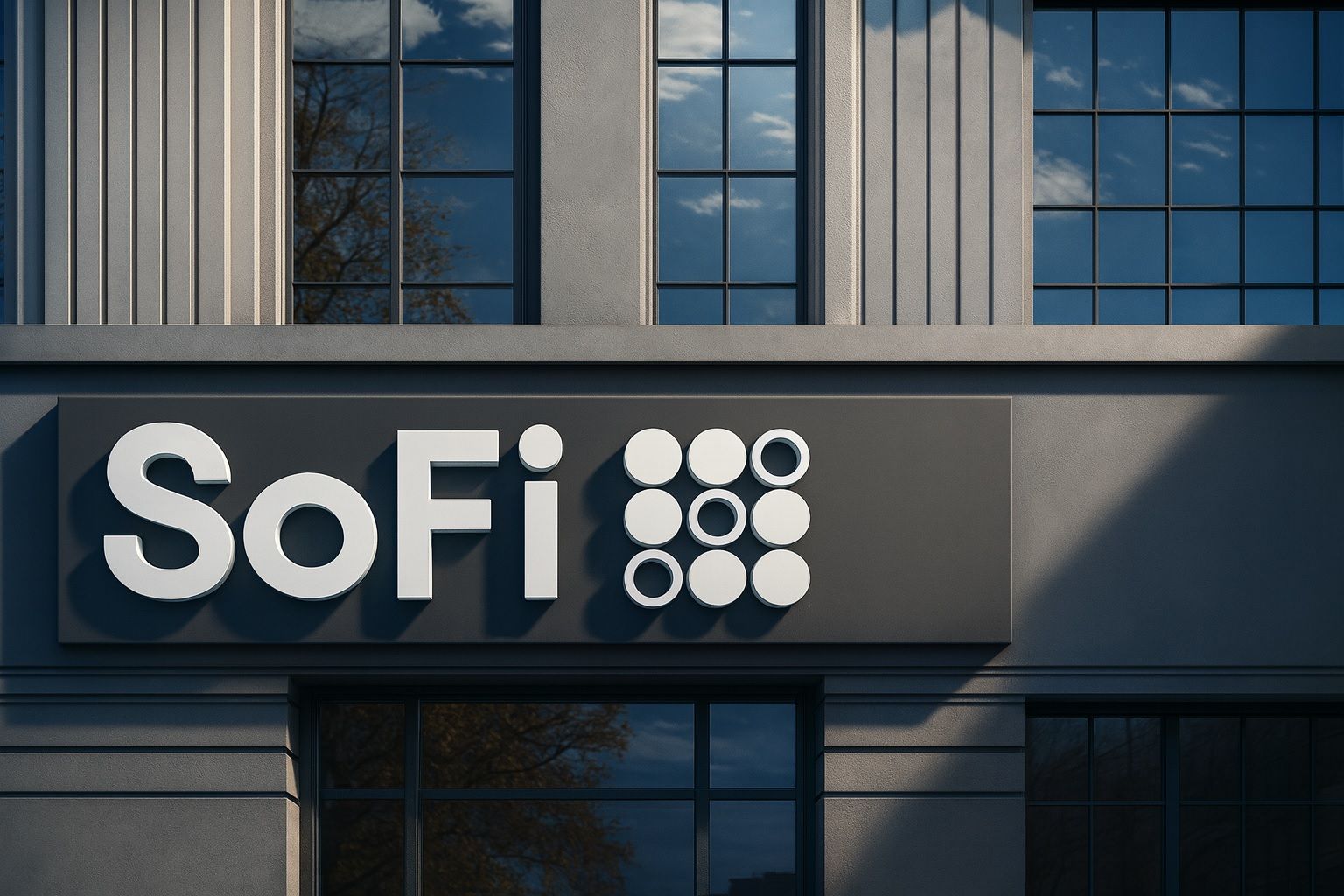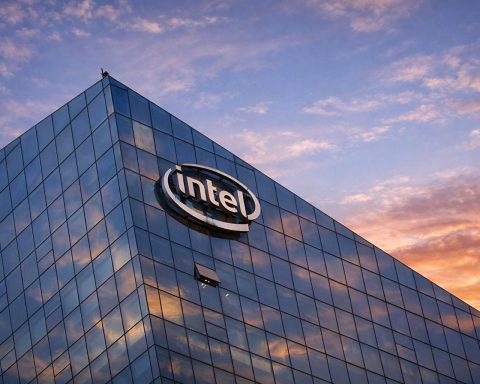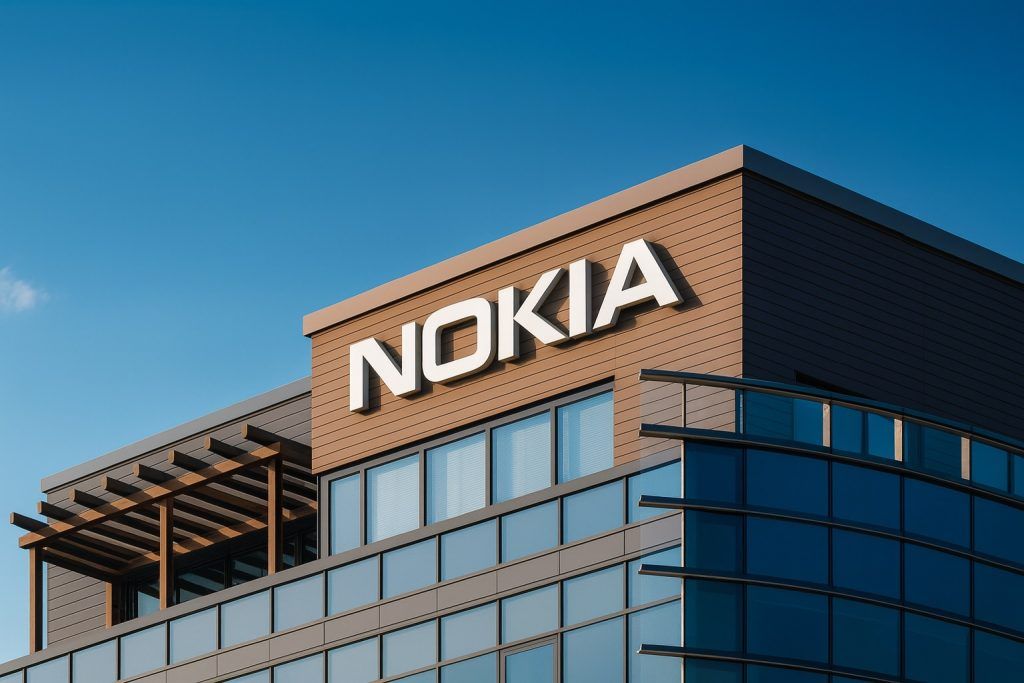- Spectacular Rally: SoFi Technologies (NASDAQ: SOFI) has surged roughly 230% over the past year, recently trading around the high-$20s per share [1]. After a volatile early October, shares rebounded ~8% on Oct. 20 alone, following an upbeat analyst upgrade, and are now up about 70% year-to-date [2]. (As of Wednesday afternoon, SOFI stock hovered near $28.8, little changed on the day [3] and not far from its 52-week high of ~$30.30 set in late September [4].)
- Upcoming Earnings Catalyst: SoFi will report Q3 2025 earnings on Oct. 28 before the market opens, and expectations are high. Wall Street forecasts about $880 million in revenue (+27% YoY) and EPS of ~$0.08 (+60% YoY) [5] [6]. The fintech beat estimates last quarter (Q2 2025 EPS came in at $0.08 vs $0.06 expected) and subsequently raised its full-year revenue guidance to roughly $3.37 B (about +30% YoY) [7] – so investors are eager to see if SoFi can deliver another upside surprise.
- Fintech Expansion – New Products & Partnerships: SoFi has been aggressively expanding its “one-stop-shop” financial platform. In early October, it launched commission-free stock options trading for retail investors (letting even beginners trade covered calls and puts with zero fees) [8]. Last month it also rolled out a new AI-focused ETF (NASDAQ: AGIQ) targeting next-gen tech names, bolstering its lineup of in-house investment products [9]. On the crypto front, CEO Anthony Noto revealed plans to enable blockchain-based international money transfers by late 2025 (through a partnership with Bitcoin Lightning startup Lightspark) and even to launch an FDIC-insured stablecoin once regulators allow [10]. Meanwhile, SoFi’s banking-tech unit Galileo just joined Amazon’s AWS Partner Network in mid-October, aiming to make its cloud-based payments platform accessible to more banks and fintechs globally [11]. (Galileo’s longtime CEO recently stepped down amid “record” growth, underscoring SoFi’s momentum in fintech infrastructure [12].)
- Stock Fuel from Student Loan News: SoFi’s roots in student loan refinancing mean policy shifts can be game-changers. This month, Washington floated a bombshell idea: reportedly selling off portions of the $1.6 trillion federal student loan portfolio to private lenders [13]. Such a move – still under discussion – would crack open a massive market for SoFi’s refinance business [14]. Already, the resumption of federal student loan payments this fall has sparked a rebound in SoFi’s student loan activity (refinancing volume jumped ~35% last quarter as borrowers exited the payment pause) [15]. The mere prospect of a $1.6 T loan selloff has fueled bullish sentiment that SoFi could dramatically expand its loan book, although no decisions are final [16].
- Analysts Split on Valuation: After its meteoric rise, experts hold sharply divided views on SOFI stock. Bulls argue SoFi is executing exceptionally – Mizuho recently reiterated a Buy and hiked its price target to $31, citing the company’s “strong rate-driven outlook” and ability to benefit as interest rates eventually ease [17]. Some high-profile investors are also optimistic: “SoFi isn’t just another flashy meme-like fintech story – it’s a fast-growing business now proving its financial maturity,” says Michael Wiggins De Oliveira, a top-ranked investor who rates the stock a Strong Buy [18] [19]. However, skeptics believe the upside is already priced in. Morgan Stanley pegs SoFi’s fair value around $18 and maintains an Underweight (Sell) rating, warning that at nearly 50× forward earnings the stock has “a lot of good news” baked in [20]. Similarly, KBW analysts, while raising their target to $18, still label SoFi Underperform, cautioning that the stock’s risk/reward “seems skewed negatively over the long term given the premium valuation” [21]. The overall analyst consensus sits at “Hold” with an average price target in the low-$20s [22] [23] – well below where shares trade now.
- Big Players Buying In: Despite valuation debates, SoFi has been attracting notable investors. Cathie Wood’s ARK Invest doubled down on SoFi last quarter – boosting its stake by 118% to about 4.4 million shares (roughly a 0.4% ownership) as of Q2 [24]. And insiders have taken some profits after the huge run-up (SEC filings show a few executives sold shares in late summer at prices in the mid-$20s) [25] [26], which is not unusual for a stock that has more than tripled in a year. The stock also remains a retail trading favorite – it’s consistently among the most active financial stocks by volume [27] [28], reflecting its popularity (and contributing to its high volatility, with a beta near 1.9).
October Stock Surge After Volatile Weeks
SoFi’s stock has been on a roller-coaster ride in recent weeks. After reaching an all-time high around $30.30 in late September amid fintech euphoria [29], the stock stumbled through early October – falling about 10–15% from its peak as investors locked in gains and broader market jitters hit high-growth tech shares. In fact, SoFi slid for seven straight sessions to mid-month, even tumbling 5% in one day on Oct. 16 to around $26.60 [30]. “Most buyers are already in,” one analyst quipped during that pullback, suggesting the pool of new investors willing to chase the rally had shrunk [31].
This week, however, SoFi proved the bulls aren’t done. On Monday Oct. 20, the stock exploded nearly 8% higher intraday, bouncing from the mid-$26s back up to the upper-$28s [32]. Traders pinned the pop on a fresh upgrade from Zacks Investment Research to “Buy” that morning, as well as growing optimism ahead of next week’s earnings. By Tuesday’s close, SoFi held those gains – finishing around $28.75 on Oct. 21 [33] – and the stock is roughly flat at that level as of Wednesday afternoon. At around a $28–$29 share price, SoFi’s market capitalization sits in the low-to-mid $30 billion range [34], an eye-popping figure that actually rivals some established regional banks. This underscores the market’s confidence in SoFi’s growth story – but also the rich valuation being assigned to a still-young financial firm [35] [36].
Notably, trading volumes have been heavy, underscoring intense interest in SOFI. Over 56 million shares changed hands on Tuesday alone [37], and Oct. 16’s sell-off saw volumes about 16% above average [38]. Such high activity is a double-edged sword: it means high liquidity and investor attention, but it also reflects heightened volatility. At ~1.9, SoFi’s beta indicates it is nearly twice as volatile as the overall market [39]. In practice, 5–10% swings in a week (or even a day) have become almost routine for this stock – as both fervent bulls and bearish short-sellers actively trade on every piece of news.
Market technicians are watching to see if SoFi’s recent pullback was a healthy breather or a warning sign. Before this week’s rebound, the stock had been drifting toward its 10-week moving average – a technical support level that in past rallies has served as a springboard for SoFi [40]. The fact that buyers stepped in around the mid-$20s suggests that dip buyers are alive and well, likely betting that upcoming catalysts (like the earnings report) could propel a fresh leg higher. Even after the October wobble, SoFi remains one of 2025’s top-performing financial stocks, dramatically outperforming fintech peers like PayPal, Block, and Affirm, which have struggled this year. SoFi’s unique edge – it’s a fintech that owns a national bank charter and has posted seven consecutive quarterly profits [41] – may be giving investors extra conviction that this isn’t just another hype stock.
Earnings on Deck: Can SoFi Beat Expectations Again?
The next major catalyst for SOFI is just days away: Q3 2025 earnings are due on October 28. Analysts are universally expecting robust growth – the consensus calls for about $0.08 in EPS and ~$880 million revenue for the quarter [42], which would mark roughly +60% higher earnings and ~+27–28% revenue growth year-over-year [43] [44]. If achieved, that would be a continuation of SoFi’s strong trend: last quarter (Q2), revenue jumped 44% and adjusted earnings leapt from practically breakeven a year ago to $0.08 per share [45]. That Q2 report in late July impressed the market – SoFi not only beat estimates but also raised its full-year outlook, citing momentum across its businesses [46].
Investors will be watching closely to see if CEO Anthony Noto and his team can deliver another beat-and-raise. SoFi’s management has exuded confidence, pointing to accelerating member growth and cross-selling success. In Q2 alone, SoFi added 850,000 new members – a 34% YoY increase – bringing total users to 11.7 million [47] [48]. These customers are using more SoFi products than ever (over 17 million products in total, +34% YoY) [49], as many start with one service (like a loan or savings account) and then adopt others (investing, credit card, etc.). This “financial super-app” strategy appears to be working: notably, SoFi’s non-lending segment (which includes checking, savings, investment accounts, credit cards and more) is now growing even faster than its core lending business. In Q2, non-lending financial services revenue surged 106%, and its contribution profit jumped 241% to $188 million – nearly matching the profits from SoFi’s lending division [50]. In short, SoFi is proving it can diversify beyond student and personal loans, using attractive banking products to reel in customers and then upselling them into higher-margin offerings.
Crucially, SoFi has also achieved something many fintechs haven’t: GAAP profitability. The company turned profitable in late 2024 and has now notched seven straight quarters in the black (GAAP) through mid-2025 [51]. For the full year 2025, consensus earnings are around $0.32/share [52] – roughly flat versus 2024 as SoFi reinvests for growth – but solidly positive. That profitability milestone, alongside a national bank charter acquired in 2022, gives SoFi a level of credibility (and funding stability via bank deposits) that many rival fintechs lack [53]. It’s one reason SoFi’s stock has vastly outpaced names like Robinhood or Affirm this year [54], and it provides a safety net; profitable companies can better weather economic storms.
When SoFi reports next week, investors will focus not just on whether Q3 meets or beats estimates, but how the outlook ahead is shaping up. Any updates to 2025 guidance or hints about 2026 targets could move the stock [55]. For instance, if management raises their full-year revenue or profit forecast again, it would signal that strong growth is persisting into Q4. Also key will be SoFi’s loan performance metrics – delinquencies and charge-off trends – given concerns about consumer debt. So far, SoFi’s credit quality has held up well even as its lending book expands; in fact, personal loan delinquency rates have improved five quarters in a row [56], which one expert calls “absolutely key” to proving SoFi is a “serious business” and not just a meme stock [57] [58]. If Noto can show that SoFi’s growth is not coming at the expense of credit quality or margins, it will bolster the bull case. On the flip side, any hint of rising defaults or a growth slowdown (perhaps due to higher interest rates) could give bears ammunition.
Wall Street will also parse the commentary on the earnings call for insight into 2026 and beyond. SoFi’s long-term plan, as previously outlined by management, aimed for around $0.55–$0.80 in EPS by 2026 if all goes well [59]. With 2025 nearly in the bag, analysts will be looking to see if the company still appears on track for that trajectory – or possibly even more ambitious targets – given the slew of new initiatives coming online.
Fintech “Super-App” Moves: Options, Crypto, and More
One reason SoFi has been able to sustain such torrid growth is its continuous rollout of new products and features that deepen its ecosystem. In just the past few weeks, SoFi made waves with several expansions:
- No-Fee Options Trading: In early October, SoFi opened up stock options trading to its members, with a twist – it’s charging no commissions or contract fees [60] [61]. This is a big deal in retail investing; options have traditionally been the domain of more sophisticated traders on platforms like Robinhood or TD Ameritrade. SoFi’s move, first reported by Bloomberg, lets even novice investors try basic options strategies (like covered calls and cash-secured puts) right in the SoFi app [62]. By eliminating fees, SoFi is clearly aiming to attract younger users who are curious about options but wary of costs, and to keep existing customers engaged on its platform rather than migrating elsewhere for more advanced trading. Management has hinted this is just “Level 1” and that more advanced options capabilities (such as options in retirement accounts and same-day expirations) are coming over time [63]. The launch also complements SoFi’s push into fractional share trading, crypto trading, and even IPO investing, as the company positions its app as a one-stop investment hub for the next generation.
- AI-Powered Investment Products: Tapping into 2023–2024’s AI stock boom, SoFi in September debuted the SoFi “Agentic” AI ETF (AGIQ) [64]. This thematic exchange-traded fund focuses on companies advancing “agentic” artificial intelligence – essentially, AI that can adapt and act autonomously. The fund holds high-profile tech names like Salesforce, Tesla, and Nvidia, riding the buzz around AI innovation [65]. “We’re excited to add AGIQ to our ETF suite to give members another opportunity to tap into the next evolution of AI,” said SoFi’s Head of Advice, underscoring the goal to offer cutting-edge themes to investors [66]. SoFi already runs a family of ETFs (covering areas like the gig economy, Web3, etc.), and launching an AI fund not only broadens that roster but also reinforces SoFi’s image as an innovative fintech willing to jump on emerging trends. The timing was savvy – interest in AI stocks has been red-hot in 2025, and SoFi likely hopes to capture some of the inflows from retail investors seeking an easy way to invest in the AI revolution.
- Crypto and Payments Innovations: SoFi is doubling down on crypto-related offerings, blurring the lines between traditional finance and blockchain. On the same day it launched options trading, CEO Anthony Noto announced a suite of upcoming “crypto-powered” features [67]. By late 2025, SoFi plans to roll out the ability for members to buy and sell major cryptocurrencies directly (it already lets users invest in crypto through third parties, but this sounds like a more integrated trading experience). More intriguingly, SoFi is piloting international money transfers via blockchain. Thanks to a partnership with Lightspark (a startup building on Bitcoin’s Lightning Network), SoFi will enable users to send money abroad instantly with minimal fees – starting with U.S.-to-Mexico remittances [68]. “We want to give members faster, smarter, and more inclusive access to their money,” Noto said, highlighting how blockchain could make global payments cheaper and quicker [69]. This move could put SoFi in competition with traditional remittance providers (like Western Union) if it expands globally. And as a bold forward-looking bet, SoFi even intends to launch its own stablecoin (a cryptocurrency pegged to the U.S. dollar) that would be FDIC-insured, pending regulatory approval [70]. If regulators eventually green-light that, SoFi could become one of the first fintechs to issue a mainstream stablecoin, potentially leveraging it for payments or deposits within its ecosystem. All these efforts signal that SoFi sees crypto as more than just a speculative asset class – it’s being treated as an enabling technology for the future of banking and payments.
- Galileo and B2B Growth: It’s not just consumer-facing products – SoFi is also expanding its presence behind the scenes in fintech. Galileo, the API and payments platform SoFi acquired in 2020, has been a quiet workhorse powering accounts for numerous fintech apps. In mid-October, Galileo announced it joined the AWS Partner Network, a move that makes Galileo’s cloud-based payment processing available through Amazon’s ubiquitous cloud platform [71]. This partnership means any bank, fintech startup, or brand building on AWS can more easily integrate Galileo’s services – potentially a big boost to Galileo’s reach. “Every company today needs access to flexible financial infrastructure… By joining AWS, we’re meeting businesses where they are,” said Galileo’s CRO in the announcement, noting it will be faster for companies to tap Galileo’s tech via AWS [72]. Alongside this, Galileo earned industry accolades (ranked #1 in a 2025 digital payments provider scorecard) [73], highlighting its strength in issuing cards and processing transactions at scale. There was also a leadership shakeup: Galileo’s CEO Derek White resigned in October after four years (having achieved “record revenue” and even hitting the famed “Rule of 40” metric for growth plus profitability) [74]. SoFi promoted Galileo’s CFO, Bill Kennedy, to CEO, signaling confidence in continuity. The Galileo developments matter to SoFi’s story because they show SoFi is not just a consumer app – it’s also a B2B fintech platform provider, generating technology revenues and expanding globally in the infrastructure layer of finance. That diversification could further boost SoFi’s growth (and valuation) if Galileo lands more clients via AWS and other channels.
$1.6 Trillion Wildcard: Student Loan Market in Focus
One of the biggest potential game-changers for SoFi on the horizon is the evolving situation in the U.S. student loan market. SoFi was originally founded to refinance student loans, and while it has branched out significantly, student debt remains a key part of its business (about a quarter of SoFi’s lending activity historically). For the past three years, that business was depressed due to the federal student loan payment moratorium – but now the tides are turning sharply in SoFi’s favor.
First, the payment pause officially ended this fall (interest started accruing again in September and monthly payments resumed in October for federal borrowers). This means tens of millions of Americans are confronting student loan payments again, and many are likely exploring refinancing options to lower their rates or monthly bills. SoFi has already reported an uptick in demand: in Q2, as the end of the pause neared, student loan refinancing originations jumped 35% year-over-year [75]. Management expects that trend to strengthen in Q4 and into 2026 now that borrowers can no longer stay on the 0% interest holiday. This resumption was a known catalyst – one reason SoFi stock started climbing earlier in 2025 was the anticipation of the moratorium’s end.
But an even bigger bombshell hit in October: according to a Politico report, the U.S. government is considering selling off portions of its $1.6 trillion federal student loan portfolio to private companies [76]. The report (which Reuters also covered) suggested that senior officials in the Department of Education and Treasury have had preliminary talks about auctioning parts of the massive federal loan book – particularly “high-performing” loans that borrowers have been reliably paying – to private lenders [77]. In theory, this could transfer a chunk of federal loans into the private market, where companies like SoFi could then refinance them or service them. For SoFi, the opportunity would be enormous: even capturing a few percentage points of $1.6 trillion in loans could translate to tens of billions in refinancing volume. Little wonder, then, that this news set fintech investors abuzz. “The government is the biggest student loan issuer and is reportedly considering selling some of the debt it owns,” noted Yahoo Finance, explaining “why SoFi stock spiked” on the chatter [78]. Indeed, SoFi’s share price jumped in the days around the report’s circulation (though broader market movements make the exact impact hard to quantify).
It’s important to stress that no decision is made yet – and such a move would likely face political and logistical hurdles. Reuters could not immediately verify the Politico report [79], and it’s unclear if the current administration (or Congress) would ultimately approve selling student loans en masse. There could be concerns about disrupting borrowers’ terms or the optics of handing over federal loans to private Wall Street firms. Nonetheless, just the prospect has analysts viewing SoFi as a prime beneficiary if it materializes. SoFi’s CEO has long argued that his company can offer better rates and services to borrowers than the government’s cumbersome loan system, and now that argument might gain traction. Any concrete move to privatize student debt – even a small portion – would likely send SoFi’s stock soaring further, given the sheer scale of what’s at stake. For now, investors are watching for any policy signals; this wildcard will be a key question on upcoming earnings calls and an overarching theme as the 2024 election approaches (since student debt policy could shift with a new administration or Congress).
In the meantime, SoFi is already benefiting from a more modest policy change: the return of federal loan collections. It means more borrowers may look to refinance to get lower rates or different terms. With average student loan interest rates on federal loans around 6–7%, and SoFi often advertising refinancing in the mid-5% range (for qualified borrowers), SoFi stands to gain significant new business in the coming quarters. This tailwind, combined with SoFi’s broadened product suite (so refinancing customers could be cross-sold into bank accounts, credit cards, etc.), forms a key part of the bullish narrative going forward.
Wall Street Forecasts and Expert Opinions: Bulls vs. Bears
After a 230% share price gain in twelve months, it’s no surprise that opinions on SoFi’s future are sharply divided. The stock’s rapid ascent has been fueled by outsize growth and improving financials, but detractors point to a valuation that already assumes perfection. Here’s a look at the contrasting perspectives:
Bullish Case: Optimists believe SoFi is only beginning to tap its potential as a next-generation financial giant. They point to the company’s blistering growth (revenue up ~30–40%, user base up ~30% YoY) and its unique positioning as a diversified fintech with a bank license. “SoFi is a fast-growing business that’s now proving its financial maturity,” argues Michael Wiggins De Oliveira, a highly rated independent investor on TipRanks, who sees the company as fundamentally strong [80]. He highlights that SoFi has managed to grow while actually improving metrics like credit quality and profitability – a sign that it’s “more than just a meme stock” or flash-in-the-pan fintech [81] [82]. Many bulls also believe that as interest rates eventually decline (perhaps in 2024–2025 if inflation cools), SoFi’s businesses will get an extra boost. Lower rates would likely spur more refinancing activity (for both student and personal loans) and reduce SoFi’s own cost of capital. Mizuho’s analyst Dan Dolev, who recently reasserted his Buy rating, noted that among fintech and consumer lenders, SoFi is especially well-positioned to benefit from rate cuts – he says SoFi’s “strong rate-driven outlook” means earnings could accelerate further, justifying a $31 price target on the stock [83]. Other positives cited by bulls include SoFi’s expanding product set (which increases share of wallet per customer), its marketing reach (national TV ads, NFL stadium naming rights have boosted brand recognition), and the fact that SoFi now has a bank charter which gives it a low-cost source of funding (member deposits) to fund loans. Some even make bold predictions: one Motley Fool analyst mused that at its current growth clip, SoFi could be worth more than Capital One by 2030 [84] – a provocative comparison between the upstart fintech and a banking heavyweight. While that may be far-fetched, it underscores the sentiment that SoFi is on a trajectory to join the big leagues of American finance if it continues executing.
Bearish Case: On the other hand, skeptics contend that SoFi’s stock has run too far, too fast relative to its fundamentals. Even supporters acknowledge the valuation is rich: at ~$29, SoFi trades around 50 times forward earnings, a multiple that assumes years of high growth ahead [85]. If any hiccup occurs – a growth slowdown, a spike in loan defaults, a regulatory snag – the stock could correct sharply. Morgan Stanley recently raised its price target on SoFi to $18 (from $13) but still urges caution with an Underweight/Sell rating [86] [87]. Morgan Stanley’s analysts argue that while SoFi is executing well, much of the optimism is already “priced in” – in other words, the market is valuing SoFi as if it will conquer the world, leaving little margin for error [88]. They and others also worry about competitive pressures: SoFi faces formidable rivals on many fronts (big banks like JPMorgan chasing the same retail deposits and loans, fintechs like Robinhood or Coinbase in trading and crypto, upstarts in digital lending, etc.). If growth in user acquisition or product adoption slows, SoFi’s high valuation could rapidly compress. The recent insider selling – for instance, SoFi’s CTO and an EVP sold chunks of stock around the $22–$27 levels over the summer [89] [90] – gives bears fodder to say even some executives find the current price a good point to take profits. Additionally, some analysts note that SoFi’s total loan portfolio has been growing, which means increased exposure to consumer credit risk at a time of economic uncertainty. The company’s personal loan segment, in particular, has expanded (originations up 66% YoY in Q2) [91], raising questions about how those loans would perform in a weaker economy or if unemployment rises.
Valuation remains the flashpoint. As mentioned, KBW’s Timothy Switzer upgraded SoFi’s target to $18 but still labels it underperform, bluntly stating the stock’s “risk/reward seems skewed negatively… given the premium valuation” [92]. In plain English, that means SoFi’s current price leaves more downside risk than upside, in his view, especially long-term. The consensus of analysts now sits at roughly Hold, with 17 analysts covering SOFI: about 5 Buys, 8 Holds, and 4 Sells, according to TipRanks data [93] [94]. The average 12-month price target is around $21–$22, which is ~20% lower than the current stock price [95]. That implies many on Wall Street think SoFi’s big 2025 rally may have overshot what the company can fundamentally achieve in the near term.
So far, the bulls have clearly had the upper hand in 2025 – and those who believed in CEO Anthony Noto’s vision have been handsomely rewarded. But going forward, market sentiment could swing quickly on any news. Rising interest rates earlier this year initially hurt growth stocks like SoFi, but now the narrative has flipped to rate cuts helping it – any change in macro outlook (e.g. if inflation flares up again) could alter that equation. Regulatory developments (like the outcome of that student loan selloff idea, or any new bank capital rules affecting fintechs) are another wild card.
For now, SoFi sits at a fascinating crossroads: a beloved fintech momentum stock that has graduated into a profitable, diversified financial firm – yet still carries a valuation premium that requires flawless execution. The coming earnings report and guidance update on Oct. 28 will be critical in determining whether SoFi’s stock can sustain its gravity-defying run or if a reality check is in order. As one market strategist put it, “This is where the rubber meets the road – the numbers need to justify the hype.” If SoFi delivers, the stock’s incredible rally could very well continue into the new year. If not, even passionate believers might concede that some of 2025’s froth needs to settle. Either way, SoFi has unquestionably become one of the most closely watched fintech stocks on the market – and its journey from here will make for must-see financial news.
Sources: SoFi Technologies market updates [96] [97]; TS² TechStock financial analysis [98] [99]; Reuters and Politico policy reports [100] [101]; TipRanks and MarketBeat analyst insights [102] [103]; Company press releases and filings [104] [105].
References
1. ts2.tech, 2. ts2.tech, 3. www.marketbeat.com, 4. ts2.tech, 5. ts2.tech, 6. www.tipranks.com, 7. ts2.tech, 8. ts2.tech, 9. ts2.tech, 10. ts2.tech, 11. ts2.tech, 12. ts2.tech, 13. www.reuters.com, 14. ts2.tech, 15. ts2.tech, 16. www.reuters.com, 17. www.tipranks.com, 18. www.tipranks.com, 19. www.tipranks.com, 20. ts2.tech, 21. www.tipranks.com, 22. www.marketbeat.com, 23. www.tipranks.com, 24. www.marketbeat.com, 25. www.marketbeat.com, 26. www.marketbeat.com, 27. www.marketbeat.com, 28. www.marketbeat.com, 29. ts2.tech, 30. ts2.tech, 31. ts2.tech, 32. ts2.tech, 33. finance.yahoo.com, 34. www.marketbeat.com, 35. www.marketbeat.com, 36. www.marketbeat.com, 37. finance.yahoo.com, 38. ts2.tech, 39. ts2.tech, 40. ts2.tech, 41. ts2.tech, 42. ts2.tech, 43. ts2.tech, 44. www.tipranks.com, 45. www.tipranks.com, 46. ts2.tech, 47. ts2.tech, 48. ts2.tech, 49. www.tipranks.com, 50. ts2.tech, 51. ts2.tech, 52. ts2.tech, 53. ts2.tech, 54. ts2.tech, 55. ts2.tech, 56. www.tipranks.com, 57. www.tipranks.com, 58. www.tipranks.com, 59. ts2.tech, 60. ts2.tech, 61. ts2.tech, 62. ts2.tech, 63. ts2.tech, 64. ts2.tech, 65. ts2.tech, 66. ts2.tech, 67. ts2.tech, 68. ts2.tech, 69. ts2.tech, 70. ts2.tech, 71. ts2.tech, 72. www.businesswire.com, 73. www.businesswire.com, 74. ts2.tech, 75. ts2.tech, 76. www.reuters.com, 77. www.reuters.com, 78. finance.yahoo.com, 79. www.reuters.com, 80. www.tipranks.com, 81. www.tipranks.com, 82. www.tipranks.com, 83. www.tipranks.com, 84. www.fool.com, 85. ts2.tech, 86. www.tipranks.com, 87. www.tipranks.com, 88. www.tipranks.com, 89. www.marketbeat.com, 90. www.marketbeat.com, 91. ts2.tech, 92. www.tipranks.com, 93. www.tipranks.com, 94. www.tipranks.com, 95. www.tipranks.com, 96. ts2.tech, 97. www.marketbeat.com, 98. ts2.tech, 99. ts2.tech, 100. www.reuters.com, 101. www.reuters.com, 102. www.tipranks.com, 103. www.tipranks.com, 104. www.businesswire.com, 105. www.marketbeat.com







